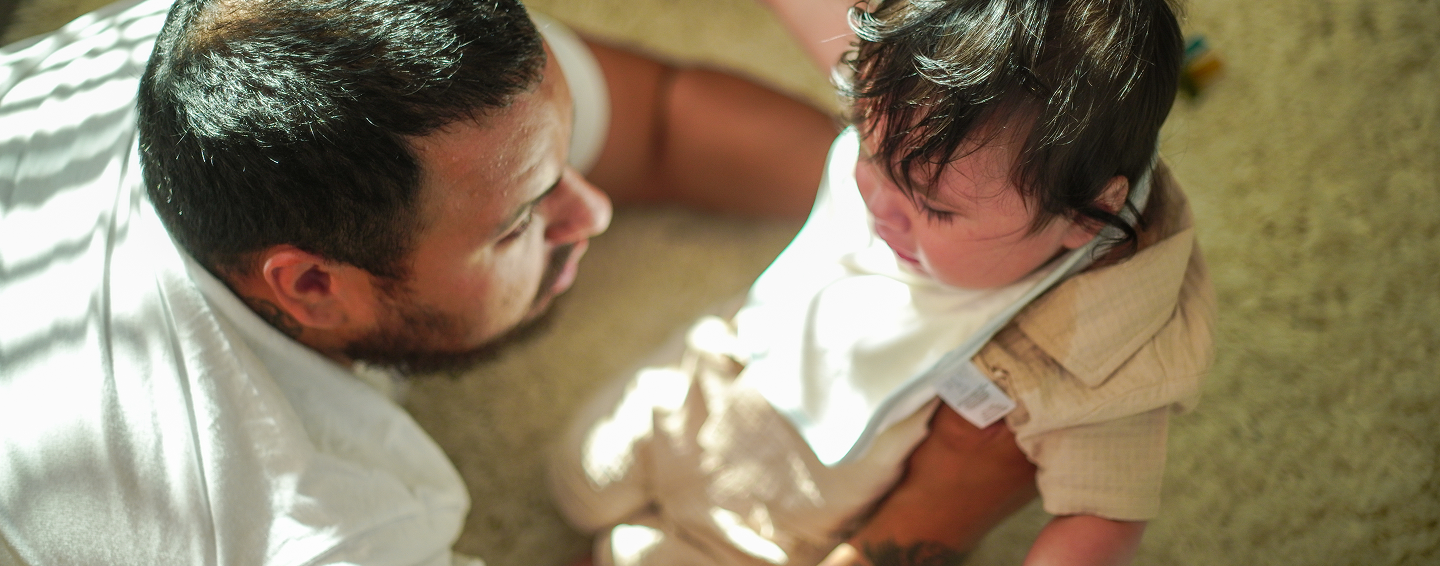Understanding Colicky Pain: When Discomfort Strikes in Waves
Colicky pain is a distinctive type of discomfort that comes and goes in intense waves, affecting both babies and adults but in very different ways. This cramping, spasmodic pain occurs when muscles contract around blockages in hollow organs like the intestines, gallbladder, or kidneys.
Quick Answer: What You Need to Know About Colicky Pain
- In babies: Intense crying for 3+ hours daily, 3+ days per week, for 3+ weeks (the "3-3-3 rule")
- In adults: Wave-like abdominal pain from gallstones, kidney stones, or intestinal blockages
- Key feature: Pain intensifies then subsides in predictable cycles
- Duration: Baby colic typically peaks at 6 weeks, resolves by 3-4 months; adult episodes last 20 minutes to 5 hours
- Prevalence: Affects 20% of babies worldwide; 10% of adults experience renal colic at some point
For new parents, colicky pain often feels like an endless mystery. As one parent described it: "Babies cry. A lot. It's what they do. But if your baby cries nonstop for more than three hours a day at least three days a week, they may have colic."
The wave-like pattern is what makes colicky pain unique. Unlike constant aching, this discomfort builds to a peak, then fades - only to return again. In babies, this usually means predictable evening crying spells that seem to follow no logical pattern. In adults, it signals something blocking the normal flow through organs like the gallbladder or kidneys.
Understanding this pattern is the first step toward finding relief. Whether you're dealing with a colicky infant or experiencing adult colicky pain yourself, recognizing the signs helps you respond appropriately and know when to seek medical help.
I'm Gary Harutyunyan, and I understand the exhaustion that comes with colicky pain - both as a new father who struggled with my baby's sleep challenges and as someone who's dedicated to helping families find relief. My experience creating solutions for colicky babies has taught me that understanding the root cause is essential for finding the right approach to comfort and healing.
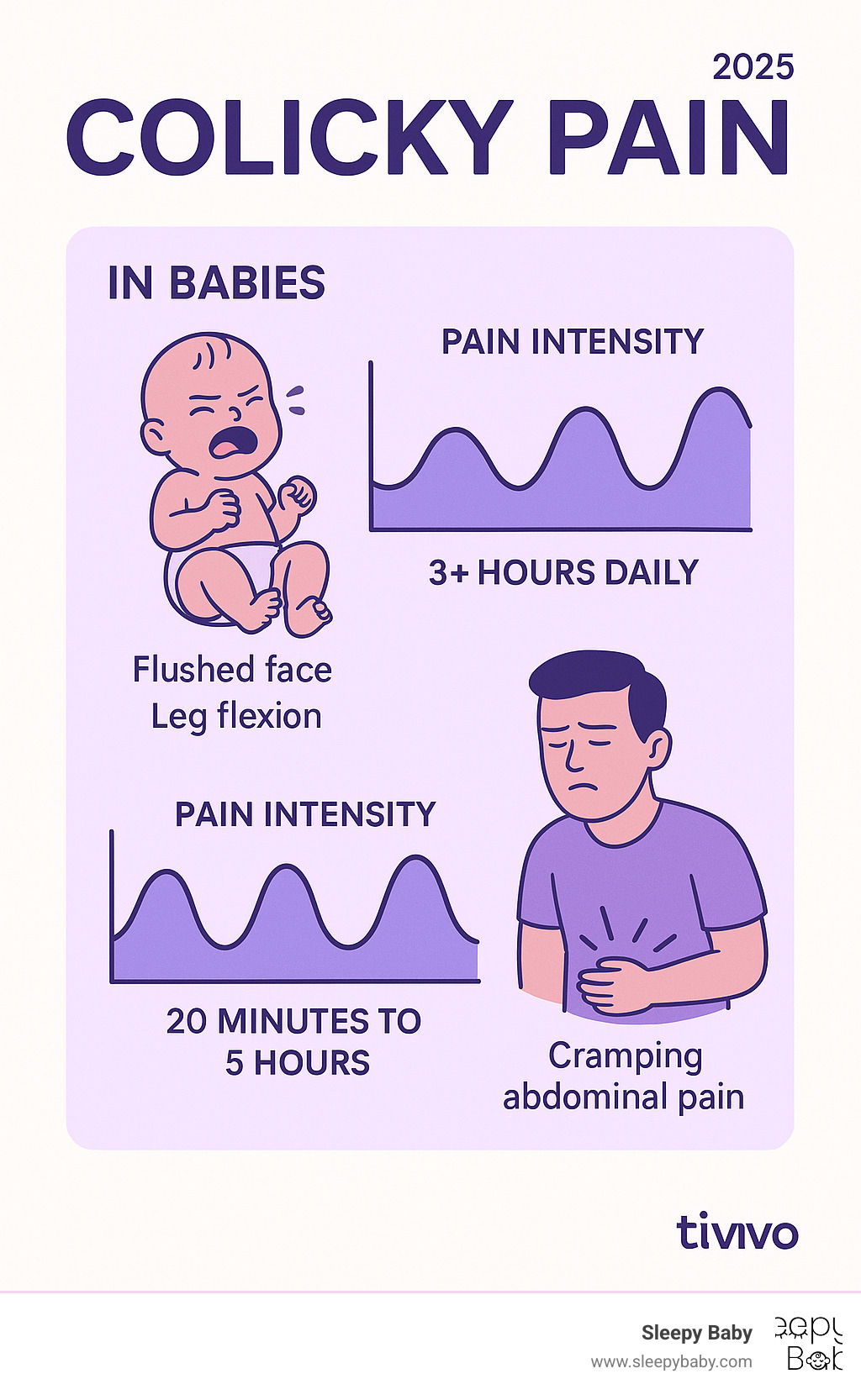
Colicky Pain 101: Definition, Types & Mechanisms
When your baby suddenly starts crying inconsolably at 7 PM every evening, or you're doubled over with waves of abdominal pain that come and go, you're likely experiencing colicky pain. This isn't your typical ache or discomfort - it's something much more intense and predictable.
Colicky pain happens when the smooth muscles in hollow organs squeeze and contract around something that's blocking the normal flow. Picture trying to squeeze toothpaste through a tube that's been twisted shut - that's essentially what's happening inside the body. Whether it's gas in a baby's immature intestines or a gallstone blocking a bile duct in an adult, the muscles keep trying to push things through, creating those characteristic waves of pain.
The fascinating thing about colicky pain is how similar the underlying mechanism is across all ages. In babies, their developing digestive systems struggle to process milk and manage gas bubbles. In adults, stones or blockages trigger the same muscular spasms. The pattern is always the same: intense pain builds to a peak, then fades away, only to return again.
Scientific research on colic basics shows that about one in three babies develops colic, typically appearing between 2 and 16 weeks of age. The exact cause remains a mystery, but researchers point to several factors: an immature digestive system, gas buildup, and ongoing nervous system development.
For adults, colicky pain shows up in three main ways. Biliary colic occurs when gallstones get stuck in bile ducts, often after eating something fatty like pizza or fried chicken. Renal colic happens when kidney stones try to pass through the narrow tubes connecting kidneys to the bladder. Intestinal colic develops from bowel obstructions caused by scar tissue, inflammation, or other blockages.
Your family history matters more than you might think. If you had colic as a baby, your own children are more likely to experience it too. The same goes for adult colicky pain - gallstones and kidney stones often run in families, suggesting a genetic component to these conditions.
The numbers tell an important story: 20% of babies worldwide develop colic, making it incredibly common among new parents. For adults, about 10% of people will experience renal colic at some point, while gallstones affect millions more, though many never cause symptoms.
Infant Colicky Pain: Understanding the 3-3-3 Rule
The 3-3-3 rule gives parents a clear way to identify colic: crying for more than three hours a day, more than three days a week, for more than three weeks. This isn't ordinary fussiness - it's intense, heart-wrenching crying that seems to come from nowhere.
Most parents notice crying episodes reach their worst point when babies are about 6 weeks old. Many describe being able to predict exactly when the crying will start each evening, usually between 5 PM and 8 PM. It's like their baby has an internal alarm clock set for maximum distress.
The 20% prevalence means colic is far from rare. In any new parent group, at least one family is likely dealing with these challenging evening crying sessions. What makes it even more puzzling is that colicky babies are often the healthiest, most vigorous infants - they're growing well and hitting all their milestones.
Gas seems to play a major role in infant colic. Many babies show immediate relief after passing gas or having a bowel movement, suggesting trapped air contributes to their discomfort. The immature gut theory makes sense when you consider that newborns' digestive systems are still learning how to process milk and coordinate all the complex movements needed for proper digestion.
Adult Colicky Pain: Biliary, Renal & Intestinal Waves
Adult colicky pain is often easier to diagnose because patients can describe exactly what they're feeling. Stone movement is frequently the culprit - whether it's a gallstone trying to squeeze through a bile duct or a kidney stone making its way down the ureter.
The crampy spasms can be absolutely excruciating, with some wave durations lasting up to 5 hours in severe cases. Patients often describe the pain as building to an unbearable peak, then suddenly vanishing, only to return with a vengeance 10 or 15 minutes later.
High-fat meals are notorious triggers for biliary colic. When you eat something rich or greasy, your gallbladder contracts to release bile for digestion. If gallstones are lurking in there, this contraction can push a stone into a bile duct, causing intense pain in the upper right side of your abdomen.
Renal colic follows a different pattern. The pain often peaks around 1-2 hours after it starts and may travel from your back down to your groin. Unlike biliary colic, kidney stone pain isn't usually triggered by meals but rather by dehydration or eating foods high in oxalates like spinach or chocolate.
Spotting the Waves: Symptoms, Signs & Diagnosis
Recognizing colicky pain can feel overwhelming, especially when you're sleep-deprived and worried about your little one. The good news? Once you understand the telltale signs, you'll be better equipped to identify what's happening and when to seek help.
The wave-like pattern is your biggest clue - pain that builds up like a storm, reaches an intense peak, then suddenly calms down before starting all over again. It's this predictable cycle that sets colicky pain apart from other types of discomfort.
In babies, the symptoms are pretty unmistakable once you know what to look for. The crying pattern is intense and high-pitched - not the usual "I'm hungry" or "I need a diaper change" cry. Your baby's flushed face during these episodes, combined with leg flexion (pulling those tiny knees up to their chest), creates a picture that's hard to miss.
You might also notice clenched fists, an arched back, and a belly that feels distended or unusually hard. Many parents report that their baby seems to find temporary relief after passing gas or having a bowel movement, which makes sense given what we know about infant digestive systems.
Adult colicky pain tells a different story but follows similar wave patterns. Flank pain from kidney stones often starts in your back and radiates down to your groin in waves that can take your breath away. Right upper quadrant pain from gallstones typically strikes after enjoying a fatty meal - your body's way of reminding you that rich foods aren't always worth it.
The restlessness is particularly telling with adult colicky pain. Unlike other types of abdominal pain where lying still helps, colicky pain often has you pacing the floor, unable to find any comfortable position. Nausea and vomiting frequently tag along, and if you're dealing with kidney stones, you might notice blood in your urine (hematuria).
Modern medical imaging has made adult diagnosis much more straightforward. Ultrasound can spot gallstones hiding in your gallbladder, while CT scans excel at finding kidney stones and intestinal obstructions. The Rome IV criteria have actually made infant colic diagnosis more flexible too, reducing the required duration from three weeks to just one or more weeks.

Some symptoms demand immediate medical attention - fever above 101°F, persistent vomiting, blood in stool or urine, severe dehydration, jaundice (that yellowing of skin or eyes), a rigid abdomen that feels like a board, or signs of shock like rapid heartbeat and low blood pressure. These red flags mean it's time to head to the emergency room, not wait for your next appointment.
Diagnosing Colicky Pain in Babies
When you bring your baby to the doctor suspecting colic, the physical examination becomes a bit like detective work. Healthcare providers look for that classic crying pattern while carefully ruling out other conditions that might be causing all that distress.
Growth tracking is one of the most reassuring parts of the diagnostic process. Colicky babies should continue gaining weight normally - if they're not, it suggests something else might be going on, like feeding problems, reflux, or food allergies.
Your doctor will also focus on exclusion of infection by checking for fever, examining tiny ears and throats, and sometimes ordering blood tests or urine cultures. It's all about making sure nothing more serious is hiding behind the crying.
Many healthcare providers recommend keeping a stool and feeding diary for at least a week. This might feel like homework when you're already exhausted, but tracking when crying starts, how long it lasts, and what provides relief helps confirm the diagnosis and monitor improvement over time.
Diagnosing Colicky Pain in Adults
Adult diagnosis starts with a detailed conversation about your pain - where it hurts, when it started, what triggers it, and what other symptoms you're experiencing. The pattern matters enormously: constant pain suggests one thing, while wave-like pain points toward colicky pain.
Laboratory tests might include blood work to check for infection, kidney function, and liver enzymes. A urinalysis can detect blood, crystals, or signs of infection - all important clues about what's causing your discomfort.
Your risk factors and family history play important roles too. Previous episodes of kidney stones, gallbladder disease, or inflammatory bowel conditions increase the likelihood you're dealing with colicky pain. Sometimes our genetics give us unwanted gifts.
The diagnostic workup varies depending on what type of colicky pain is suspected. Biliary issues are typically investigated with ultrasound and liver enzyme tests, looking for gallstones and duct dilation. Renal problems usually require CT scans and urinalysis to spot kidney stones and check for hydronephrosis. Intestinal concerns often need CT scans with contrast plus blood work to identify bowel obstructions or inflammation.
Understanding these diagnostic steps can help ease anxiety about the process. Your healthcare team is systematically working through possibilities to find the root cause of your pain and develop the most effective treatment plan.
Relief in Action: Management, Treatment & Home Remedies
When colicky pain strikes, finding relief becomes the top priority. The good news is that there are many effective strategies for both babies and adults, though the approaches differ significantly.
For babies experiencing colic, comfort measures focus on recreating the soothing environment of the womb. Swaddling your little one snugly in a blanket helps them feel secure and can reduce the startle reflex that sometimes makes crying worse. The gentle pressure mimics the cozy feeling they had before birth.
Rhythmic motion works like magic for many colicky babies. Whether it's gentle bouncing, swaying, or taking a walk with the stroller, that steady movement often brings instant calm. White noise has a similar effect - the consistent sound of a fan, vacuum cleaner, or specialized white noise machine can work wonders during those intense crying episodes.
A pacifier gives babies the comfort of sucking without feeding, which can be especially helpful if they're not actually hungry during a crying spell. Some parents find that simethicone drops help with gas-related discomfort, though results vary from baby to baby.
For breastfeeding mothers, trying a hypoallergenic formula or eliminating certain foods from your diet might help if food sensitivities are contributing to the colic. Lactobacillus reuteri probiotics have shown promise in research, reducing crying time by about an hour per day in breastfed babies.
Adult colicky pain requires a different approach entirely. NSAIDs like ibuprofen can provide significant pain relief during episodes, while antispasmodics help relax the cramping muscles in your digestive system. Hydration becomes crucial, especially with kidney stones - drinking plenty of water helps flush smaller stones through your system.
Heat packs applied to the painful area can provide comforting relief between medication doses. Many people find that a warm bath or heating pad helps them get through the worst of the pain waves.
When home remedies aren't enough, medical treatments step in. Lithotripsy uses shock waves to break up kidney stones, while laparoscopic surgery can remove problematic gallbladders with minimal recovery time. Scientific research on gallstone treatment shows these modern techniques get people back to their normal lives much faster than traditional surgery.
For those dealing with ongoing issues, More info about calming colic chaos offers additional strategies that many families find helpful.
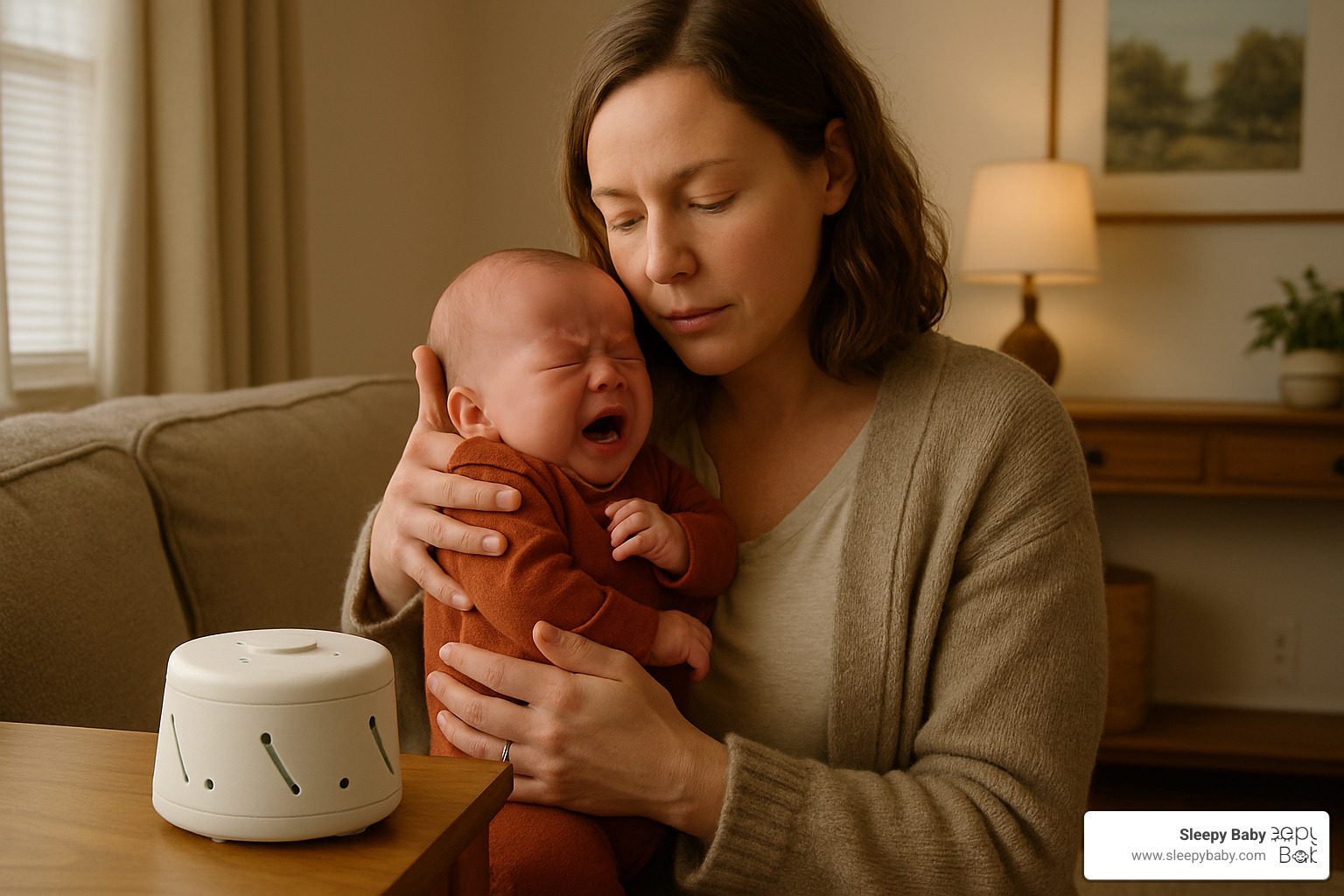
Quick Soothers for Infant Colic
Sometimes you need relief right now, and these techniques can provide immediate comfort for your colicky baby. Burping techniques matter more than you might think - try holding your baby upright against your shoulder, sitting them on your lap while supporting their chest, or laying them face-down across your lap for a different angle.
Stroller rides combine fresh air with gentle motion, and many parents swear by this combination for stopping crying episodes in their tracks. The change of scenery doesn't hurt either, especially if you've been inside dealing with crying for hours.
Warm baths can work wonders, though not every baby enjoys them. The warm water and different sensation often interrupt the crying cycle long enough for baby to calm down. Skin-to-skin contact provides comfort through your warmth and heartbeat - simply place your baby on your bare chest and let them feel your breathing.
The "colic carry" position - holding baby face-down along your forearm with their head in your palm - applies gentle pressure to their tummy while keeping them close to you. Many babies find this position particularly soothing during gas-related discomfort.
Don't overlook household sounds as potential soothers. The steady hum of a washing machine, vacuum cleaner, or hair dryer mimics the constant whooshing sounds your baby heard in the womb. For more targeted relief strategies, More info about relieving colic pain provides additional techniques that have helped countless families.
Medical & Surgical Options for Adult Colicky Pain
When conservative treatments aren't enough, medical interventions can provide the relief you need. ERCP (Endoscopic Retrograde Cholangiopancreatography) allows doctors to remove bile duct stones without major surgery, using a flexible scope passed through your mouth and stomach.
Ureteroscopy takes a similar minimally invasive approach for kidney stones. A thin scope goes through your urinary tract to locate and remove stones, often in a same-day procedure. Stent placement provides temporary relief by keeping blocked ducts open while stones pass naturally or inflammation subsides.
IV fluids play a crucial role in treatment, especially for kidney stones. Proper hydration helps flush stones through your system and prevents new ones from forming. Many patients find that increasing their fluid intake significantly reduces future episodes.
Diet modification becomes essential for long-term management. Increasing fiber intake helps prevent constipation-related intestinal colic, while reducing high-fat foods can prevent gallbladder attacks. Regular exercise keeps everything moving smoothly and helps maintain a healthy weight, which reduces your risk of developing stones in the first place.
The combination of immediate pain relief and long-term prevention strategies gives most people excellent control over their colicky pain episodes. Working with your healthcare provider to develop a comprehensive plan makes all the difference in managing this challenging condition.
Staying Ahead: Prevention, Outlook & Caregiver Support
Prevention strategies differ significantly between infant and adult colicky pain, but both focus on reducing triggers and supporting overall health.
For breastfeeding mothers, dietary modifications may help reduce infant colic. Research shows that eliminating common allergens like dairy, caffeine, onions, cabbage, nuts, eggs, and soy can reduce crying by up to 137 minutes per day compared to 51 minutes in control groups.
Adequate hydration is crucial for preventing kidney stones, while high-fiber meals help maintain healthy bowel function. Maintaining a moderate weight reduces the risk of gallstones.
The prognosis for infant colic is excellent - most cases resolve completely by 3-4 months of age. However, the journey can be exhausting for caregivers, and the emotional toll shouldn't be underestimated.
Adult colicky pain has a more variable outlook. While acute episodes resolve, recurrence is common with stones. Up to 50% of people who've had kidney stones will develop them again within 10 years without preventive measures.
Caregiver mental health is a serious concern. Studies show that colic increases the risk of postpartum depression and can strain relationships. The constant crying can trigger feelings of inadequacy and frustration in even the most patient parents.
Safe breaks are essential - if you're feeling overwhelmed, place your baby in a safe location like their crib and take a few minutes to collect yourself. This isn't giving up; it's responsible parenting.
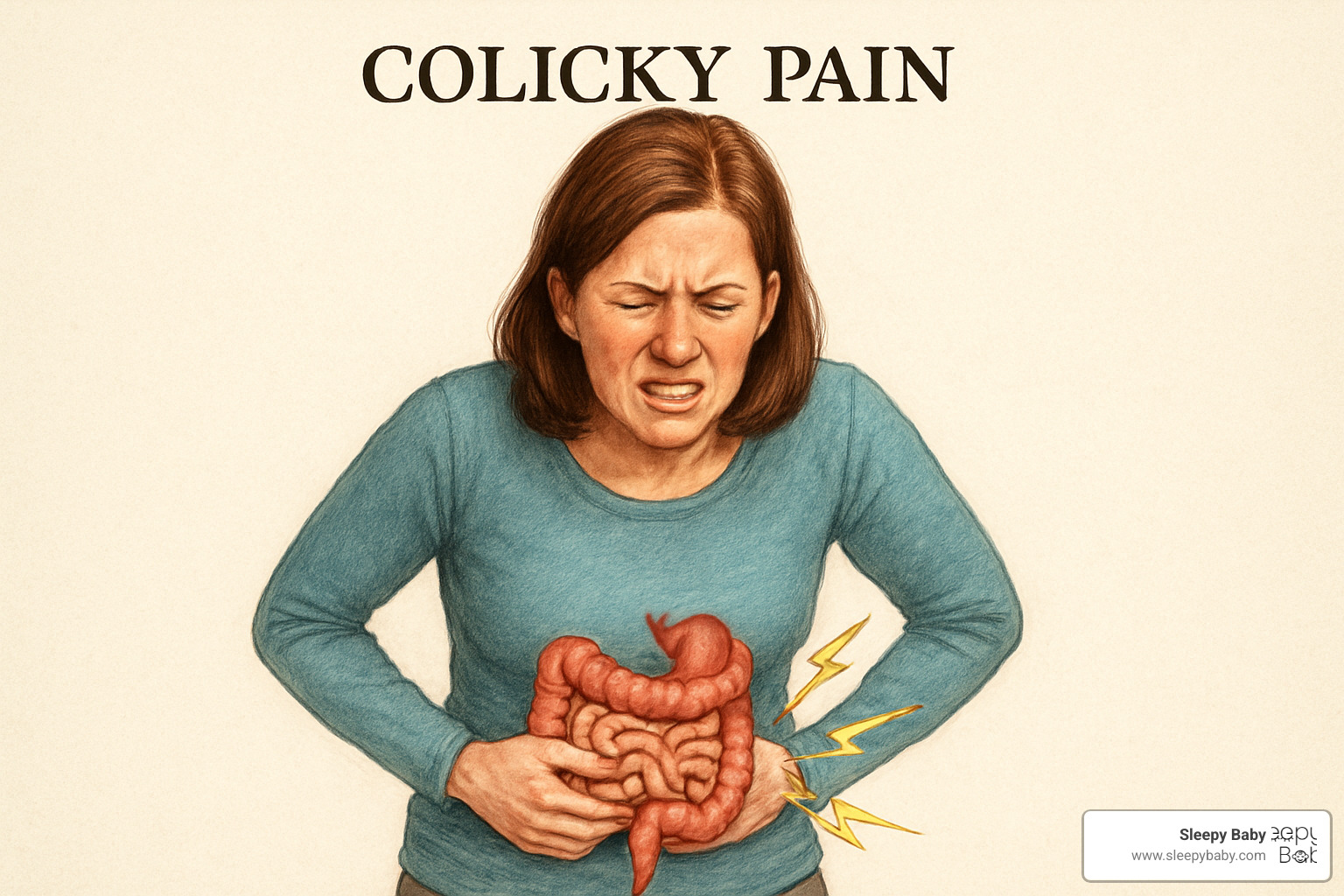
Preventing Future Colicky Pain Episodes
Stone Prevention Diet:
- Drink 8-10 glasses of water daily
- Limit sodium to less than 2,300mg per day
- Reduce animal protein intake
- Increase citrus fruits (natural citrate helps prevent stones)
- Avoid high-oxalate foods if you've had calcium oxalate stones
Regular exercise helps maintain healthy digestion and reduces the risk of gallstones. Even moderate activity like walking 30 minutes daily can make a significant difference.
Probiotics may help prevent infant colic, though more research is needed. Some studies suggest that mothers taking probiotics during pregnancy may reduce their babies' colic risk.
Coping Strategies for Parents & Partners
Rotating duties is essential for maintaining sanity. If you have a partner, take turns being "on duty" during peak crying hours so each person can rest.
Safe-crib breaks mean putting your baby in their crib when you need a moment to regroup. Babies are safe in their cribs, and a few minutes of separation can prevent caregiver burnout.
Professional help lines are available 24/7 in most areas. Don't hesitate to call your pediatrician, a postpartum support hotline, or a mental health professional if you're struggling.
Mindfulness and relaxation techniques can help manage the stress of dealing with colicky pain. Deep breathing exercises, meditation apps, or even just stepping outside for fresh air can provide relief.
Frequently Asked Questions about Colicky Pain
Why does colicky pain come and go in waves?
The distinctive wave pattern of colicky pain happens because of how our smooth muscles work when they encounter a problem. Think of it like a traffic jam - when there's a blockage, everything backs up and the muscles have to work extra hard to push things through.
In babies, those tiny intestinal muscles are still learning their job. When gas bubbles or stool move through immature intestines, the muscles contract forcefully, causing intense pain. Then they relax for a moment before trying again - creating that unmistakable cycle of crying, brief calm, then more crying.
For adults, it's usually stones causing the trouble. Whether it's a gallstone trying to squeeze through a bile duct or a kidney stone moving through the ureter, the surrounding muscles contract rhythmically, desperately trying to push the obstruction along. The pain peaks when the muscle contracts, then fades during the brief rest period.
This explains why many parents notice their baby's crying comes in predictable waves, and why adults with kidney stones often pace the floor - the pain literally comes and goes in cycles.
When should I seek medical attention for colicky pain?
While colicky pain can be exhausting and worrying, most cases don't require emergency care. However, certain warning signs mean it's time to call your doctor or head to the hospital right away.
For babies, trust your instincts if something feels different. Seek immediate care if your little one has a fever along with the crying - this could signal an infection rather than simple colic. If your baby isn't gaining weight normally or seems lethargic between crying episodes, these are red flags that need medical attention.
Forceful vomiting, especially if it contains blood, is another serious warning sign. Normal baby spit-up is common, but projectile vomiting is different and needs immediate evaluation.
For adults, the warning signs are often more dramatic. If your colicky pain comes with fever and chills, you might have an infection that needs urgent treatment. Severe pain that doesn't improve when you change positions, unlike typical colicky pain that may ease briefly, could indicate a serious complication.
Blood in your urine or stool, persistent vomiting that prevents you from keeping fluids down, or developing jaundice (that yellowing of skin or eyes) all require emergency medical care. These symptoms suggest complications that need immediate intervention.
Can colicky pain be completely prevented?
The honest answer is that we can't completely prevent colicky pain, especially in babies. Since doctors still don't know exactly what causes infant colic, there's no foolproof prevention method. It's frustrating for parents who want to protect their babies from discomfort, but some babies simply seem more prone to colic than others.
However, there are strategies that might help reduce the risk. Breastfeeding mothers can try avoiding common allergens like dairy, caffeine, and spicy foods to see if it makes a difference. Proper burping techniques and maintaining a calm environment may also help some babies.
Some research suggests that probiotics might reduce colic risk, though this should always be discussed with your pediatrician first. The key is understanding that if your baby develops colic despite your best efforts, it's not your fault - some babies just need more time for their systems to mature.
Adult colicky pain from stones can often be prevented through lifestyle changes. Staying well-hydrated is probably the most important step - drinking 8-10 glasses of water daily helps prevent both kidney stones and gallstones. Maintaining a healthy weight, exercising regularly, and following dietary recommendations from your doctor can significantly reduce your risk.
If you've had stones before, your doctor might recommend specific dietary changes or medications to prevent recurrence. Following these recommendations can cut your risk of future episodes by up to 50%.
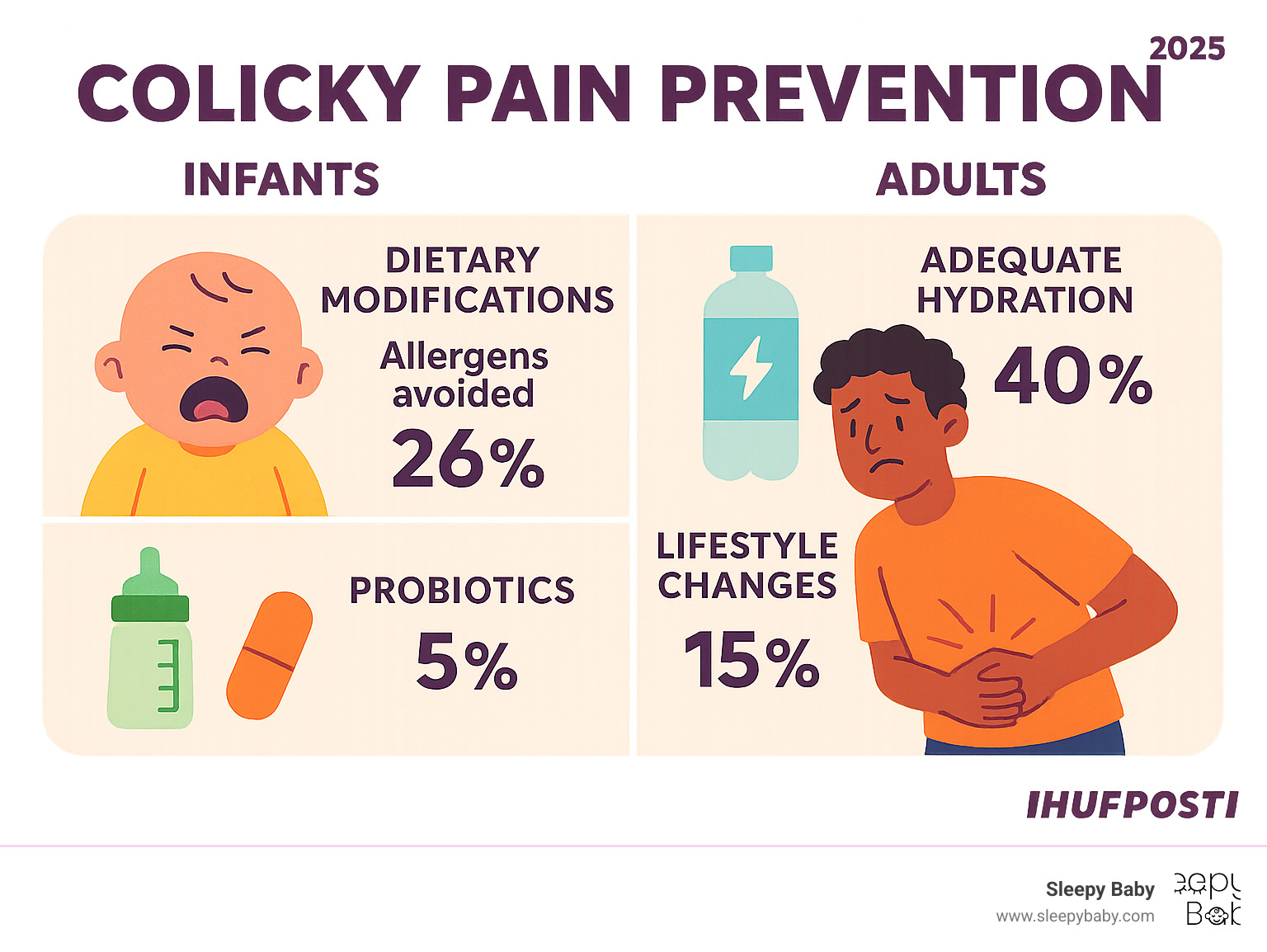
Conclusion
Colicky pain might feel like an endless storm when you're in the middle of it, but I want you to know that calmer days are ahead. Whether you're walking the halls at 2 AM with a crying baby or doubled over from your own wave of pain, this challenging time will pass.
For exhausted parents dealing with infant colic, take heart - most babies outgrow their colicky pain by 3-4 months as their little systems mature. Your baby isn't broken, and neither are you. Some babies just need extra help learning how to be comfortable in this big, bright world outside the womb.
The beauty of understanding colic is that knowledge brings options. Maybe your baby responds to gentle swaddling and rhythmic patting. Perhaps they find peace in white noise or the motion of a stroller ride. Every baby is different, and finding what works for yours is like finding a secret code that open ups their comfort.
Adults facing colicky pain have reason for optimism too. Today's medical treatments are more advanced and less invasive than ever before. From simple dietary changes to sophisticated procedures that can eliminate stones without major surgery, relief is within reach. The key is partnering with your healthcare team to find the right approach for your specific situation.
Here's what gives me the most hope: in both cases, the prognosis is genuinely positive. Infant colic leaves no lasting effects - those fussy babies grow into healthy, happy children. Adult colicky pain, while it can recur, becomes much more manageable once you understand your triggers and have a prevention plan in place.
For families in the thick of colic challenges, asking for help isn't giving up - it's smart parenting. Tools like the Sleepy Baby portable rhythmic-patting device can provide that consistent, gentle comfort your baby craves while giving you precious moments to breathe and recharge. Sometimes the best thing you can do is let technology lend a helping hand.
The waves of colicky pain may feel relentless right now, but they're not permanent. With patience, the right strategies, and support when you need it, both you and your baby will find your way to calmer waters. Trust the process, trust yourself, and remember - you're doing better than you think.


